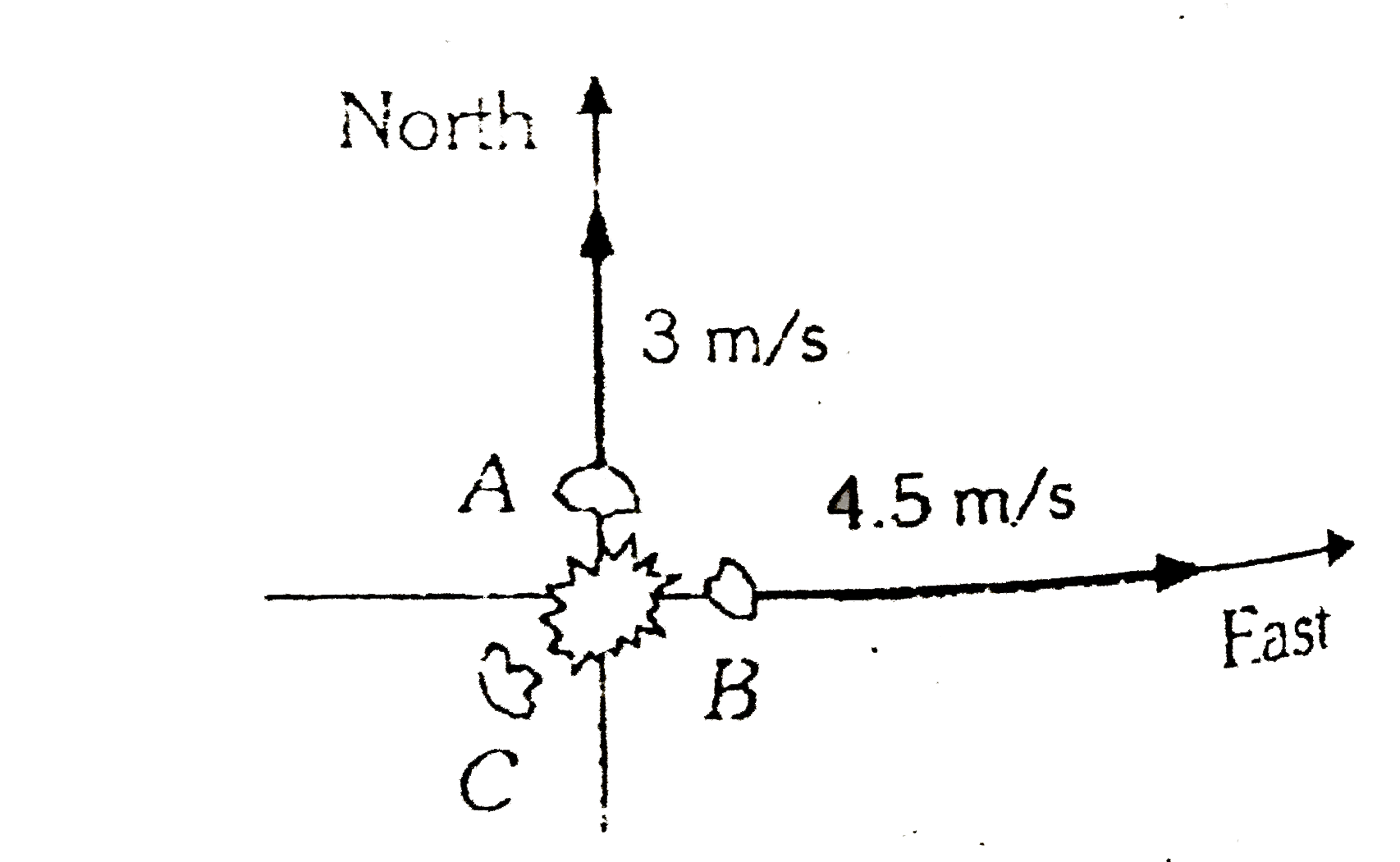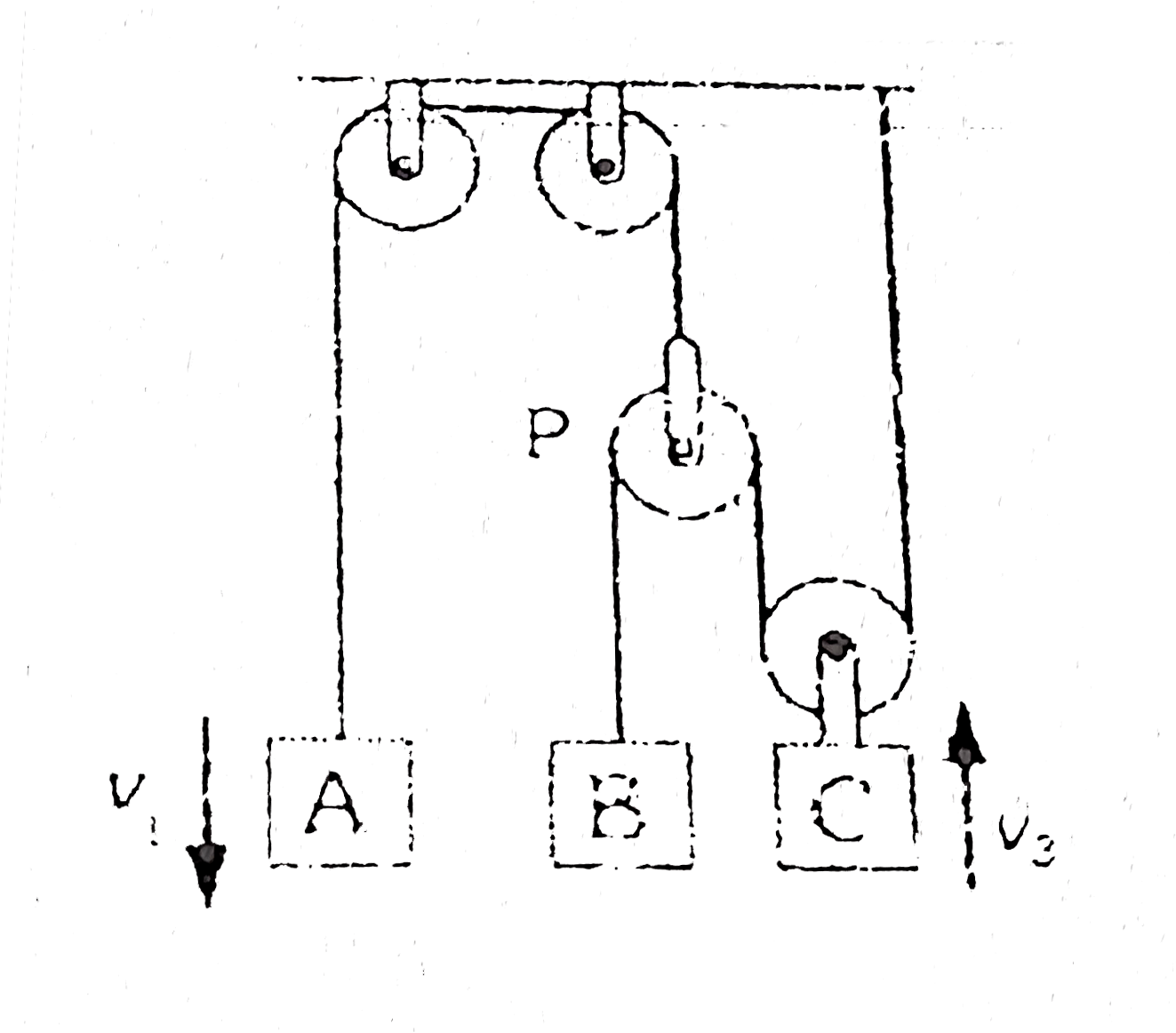A shell fired vertically up, when reaches its highest point, explodes into three fragments A,B and C of masses mA=4kg,ma=2kg and mc=3kg. Immediately after the explosion, A is observed moving with velocity vA=3m/s towards north and B with a velocity vb=4.5m/s towards east as shown in the figure. Find the velocity vc of the piece C.

Explosion takes negligible duration, therefore, impulse of gravity, which is a finite external force, can be neglelted. The pieces fly off acquiring above-mentioned velocities due to internal forces developed due to expanded gases produced during explosion. The forces aplied by the expanding gases are internal forces, hence, momentum of the system of the three pieces remains conserved during the explosion and total momentum before and after the explosion are equal.
Assuming the east as positive x-direction and the north as positive y-direction, the momentum vectors →pA and →pB of pieces A and B become
→pA=mAvAˆj=12kg−m/s and →pB=mBvBˆi=9kg−m/s
Before the explosion, momentum of the shell was zero, therefore from the principle of conservation of momentum, the total momentum of the fragments also remains zero.
→pA+→PB+→Pc=→0→ →pc=−(9ˆi+12ˆj)
From the above equation, velocity of the piece C is →vc=→pCmC=−(3ˆi+4ˆj)=5m/s,53.south west.
Topper's Solved these Questions
- CENTRE OF MASSBOOK - ALLENCHAPTER - CENTRE OF MASSEXERCISE - EXERCISE-I
40 Videos
- CENTRE OF MASSBOOK - ALLENCHAPTER - CENTRE OF MASSEXERCISE - EXERCISE-II
43 Videos
- BASIC MATHEMATICS USED IN PHYSICS &VECTORS BOOK - ALLENCHAPTER - BASIC MATHEMATICS USED IN PHYSICS &VECTORS EXERCISE - EXERCISE-IV ASSERTION & REASON
11 Videos
- ELASTICITY, SURFACE TENSION AND FLUID MECHANICSBOOK - ALLENCHAPTER - ELASTICITY, SURFACE TENSION AND FLUID MECHANICSEXERCISE - Exercise 5 B (Integer Type Questions)
3 Videos
Similar Questions
A car is moving with velocity →vc towards north and a train is moving towards east with velocity →vt . Find the direction of relative velocity of car with respect to train.
View SolutionA body is moving with velocity 30m/s towards east. After 10s its velocity becomes 40m/s towards north. The average acceleration of the body is.
View Solution
Knowledge Check
A particle moves in the direction of east for 2s with velocity of 15m/s .Then it moves towards north for 8s with a velocity of 5m/s . The average velocity of the particle is (in m/s)
A1 m/sB5 m/sC7 m/sD10 m/s
A body is moving with velocity 30m/s towards east. After 10s its velocity becomes 40m/s towards north. The average acceleration of the body is.
View SolutionA particle is moing with a velocity of 10m/s towards east. After 10s its velocity changes to 10m/s towards north. Its average acceleration is:-
View SolutionIn the system shown, the block A is moving down eith velocity v1 and C is moving up with velocity v3. Express velocity of the block B in terms of velocities of the blocks a and C.

View SolutionA Diwali cracker of mass 60 g at rest, explodes into three pieces A, B and C of mass 10 g, 20 g and 30 g respectively. After explosion velocities of A and B are 30 m/s along east and 20 m/s along north respectively. The instantaneous velocity of C will be
View SolutionTwo object A and B are moving each with velocities 10 m/s. A is moving towards East and B is moving towards North from the same point as shown. Find velocity of A relative to B (→VAB)
View SolutionA bomb of mass m is thrown with velocity v. It explodes and breaks into two fragments. One fragment of mass m', immediately after the explosion, comes to rest. The speed of the other fragment will be
View SolutionTwo bodies of different masses 2kg and 4kg are moving with velocities 2m/s and 10m/s towards each other due to mutual gravitational attraction. Then the velocity of the centre of mass is
View Solution
